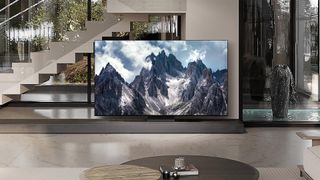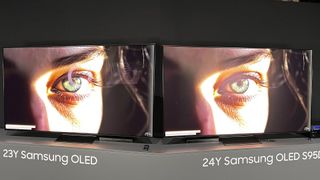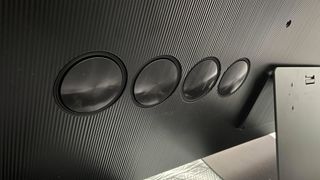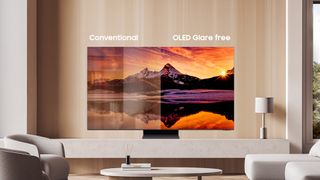Despite still being in its relative infancy by AV technology standards, Samsung’s Quantum Dot OLED panels are seriously shaking up an already complicated TV world. The arrival of the first couple of generations of this pure RGB approach to self-emissive OLED screen technology has already forced its LCD and traditional WRGB OLED (with their additional white element) rivals to try and up their games at unprecedented speeds.
Having recently just spent a few days with Samsung’s 2024 flagship S95D QD-OLED range, though, I’d say it threatens to push the TV envelope to places other current TV technologies currently cannot reach. From what I’ve seen so far, it’s fair to say that Samsung will continue to shakeup the best TVs with its next-generation QD-OLEDs.
Samsung’s S95D takes brightness to a whole new level

The single biggest reason I say this is its brightness. The first QD-OLED TVs from a couple of years ago threatened to shake things up in this respect, but the S95D takes things to a whole new level by reaching light peaks on a 10% white HDR test window – not a puny 2% one – of a fraction under 1800 nits.
The 2% measurement gets as high as 2144 nits too, but it’s the 10% one that really matters, I’d say, as it means the 65S95D is capable of delivering unprecedented amounts of brightness for OLED technology to a really wide array of high dynamic range images. To put some perspective on this, the S95D’s predecessor, the Samsung S95C and LG’s G3 OLED TV with its new-for-2023 micro lens array technology, both topped out at around 1400 nits on a 10% HDR window.
Achieving a brightness leap as extreme as the S95D’s in a single generation has a profound impact on its picture quality, especially as all that extra light has been partnered with a substantial upgrade to the picture processing Samsung deploys to get the best out of its latest QD-OLED panel.
Inside Samsung’s Neo Quantum Processor 4K brain

The S95D’s punchily named (not) Neo Quantum Processor 4K brain does a much better job of marrying the set’s extended brightness to QD-OLED’s exceptional pure RGB colour potential than its predecessor, delivering even more colour volume and vibrancy without succumbing to the occasional flared out or flattened, cartoonish tones – even in Game mode – that could occasionally creep into the S95C’s pictures.
The resulting images look nothing short of radiant in the S95D’s Standard and vastly improved Movie picture presets. Especially as, thanks to OLED’s self-emissive nature, small bright highlights in otherwise dark areas shine forth with no compromise to their brightness and intensity and none of the object dimming or backlight blooming effects you would expect to find with such picture content shown on premium LCD screens.
The S95D’s dazzling new brightness has been found, too, without it having any negative impact on the profound black tones OLED technology of all types is now renowned for. So all that remarkable new brightness can sit right alongside all that traditional blackness – literally brightest pixel next to darkest pixel – without any compromise.
The already strong sharpness we’ve come to associate with Samsung’s premium TVs continues on the S95D too. While this is particularly true with native 4K sources, the use of the collective know-how of a claimed 20 neural networks in the development of the S95D’s video processing system has also helped it improve its upscaling of sub-4K sources over anything I’ve seen before.
Samsung’s new anti-reflection filter is a standout

The S95D’s handling of dark scenes is further enhanced by the application to its screen of a startlingly effective anti-reflection filter. This soaks up reflections from your room, be they general ‘ambient’ objects or potent direct light sources, uncannily well, removing almost all traces of the familiar reflection ‘barriers’ to dark scene immersion that you would normally expect to see while watching TV in a bright room. The effect feels like looking at a matte painting rather than the usual TV ‘glass’.
There are a couple of negative side effects to this filter. Black colours can take on a slightly greyer look in bright rooms (also slightly shifting colour tones in dark areas) than they do in dark ones, and it seemed to my eyes as if there was a touch of faint blooming around the most stand-out bright objects at times that I don’t recall seeing with previous QD-OLED TVs. These issues are honestly very small prices to pay, though, for a filter that I think will benefit the all-round viewing experience of the vast majority of homes the S95D might end up in.
Sound quality is not a complete slam dunk

The Samsung S95D’s sound quality isn’t as bar-raising as its picture performance, it has to be said. As we often find with Samsung’s high-end TVs the sound feels a bit stuck behind the screen rather than projecting forward, and can’t reach the sort of room-filling volumes such bold, cinematic pictures deserve.
Though Samsung’s object tracking sound system does do a good job of making sound effects seem to be coming from the correct area of the screen. Even tracking multiple noisy objects at once as they move around the image is effective.
Has QD-OLED solved the LCD vs OLED debate?

Then there’s the premium LCD TV market to consider. The traditional argument for having both premium LCD TVs and the best OLED TVs in the marketplace has been that premium LCD TVs can deliver much more brightness than OLED TVs, making them potentially the better bet for bright rooms. Meanwhile, OLED TVs can deliver better local contrast and pixel-level light controls, making them better suited to dark home cinema rooms. With the S95D now getting into brightness territory that even many premium LCD TVs will struggle to beat or even match, though, are premium LCD TVs suddenly running out of room?
Samsung’s own upcoming QN95D flagship 4K LCD TVs might have something to say about this when they turn up, of course. As might the intriguing new mini-LED screen technology Sony unveiled at this year’s CES, along with the brand’s messaging about much more extreme brightness than even the S95D’s 1,800 nits on a 10% window being needed for potential future HDR content creation. Even the S95D’s brightness boost runs out of steam, too, compared with premium LCD technologies when it comes to showing full-screen bright images.
The S95D’s status, though, as an even more spectacular OLED brightness trailblazer than we’d expected really does have the potential to kick off some significant changes in the TV tech landscape in the coming months and years. Changes which will hopefully prove ultimately to be of benefit to us all.
You might also like
Services Marketplace – Listings, Bookings & Reviews
